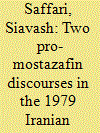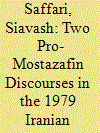| Srl | Item |
| 1 |
ID:
144719


|
|
|
|
|
| Summary/Abstract |
In contemporary Iran, many shops are under the “shop-lease contract with sar-qofli.” In this contract, sar-qofli, a strong usufructuary right supported by intangible assets such as the shop's reputation, is given to the tenant. The “shop-lease contract with sar-qofli” originated from a traditional merchants' custom in Iran's business quarters. After the 1979 Revolution, the Law of Lessor–Lessee Relationships, which provides a legal framework for the practice of “shop-lease contract with sar-qofli,” was completely revised, since Islamic jurists regarded haqq-e kasb o pisheh o tejārat as problematic. Haqq-e kasb o pisheh o tejārat, the legal designation of sar-qofli, was based on a heterogeneous value concept introduced into the Iranian legal system from abroad during World War II. As a result of this revision, another alternative for asset management was granted to shop owners. Nevertheless, “shop-lease contract with sar-qofli” remains the most widely employed form of lease in Iran's property lease market.
|
|
|
|
|
|
|
|
|
|
|
|
|
|
|
|
| 2 |
ID:
153279


|
|
|
|
|
| Summary/Abstract |
A number of studies have examined the role of the economically marginalized classes in the 1979 Iranian Revolution and the events which transpired in its immediate aftermath. It has been suggested that the mass mobilization of these classes, often referred to collectively as the mostazafin (downtrodden) in the official literature of the Islamic Republic, was instrumental in the success of the revolution and the subsequent establishment of the Islamic Republic under the leadership of Ruhollah Khomeini. The present paper contrasts Shi’i liberation theology and Shi’i Islamism as two distinct pro-mostazafin discourses that emerged in mid- and late-twentieth century Iran, and which facilitated the participation of the lower- and under-classes in the revolutionary movement. It argues that while it was developed originally by Shi’i liberation theologians, Islamist forces were able to successfully appropriate the pro-mostazafin discourse and gain the support of the economically marginalized classes in the crucial final phase of the revolution, and in doing so create an important social base for their political power.
|
|
|
|
|
|
|
|
|
|
|
|
|
|
|
|
| 3 |
ID:
154693


|
|
|
|
|
| Summary/Abstract |
A number of studies have examined the role of the economically marginalized classes in the 1979 Iranian Revolution and the events which transpired in its immediate aftermath. It has been suggested that the mass mobilization of these classes, often referred to collectively as the mostazafin (downtrodden) in the official literature of the Islamic Republic, was instrumental in the success of the revolution and the subsequent establishment of the Islamic Republic under the leadership of Ruhollah Khomeini. The present paper contrasts Shi’i liberation theology and Shi’i Islamism as two distinct pro-mostazafin discourses that emerged in mid- and late-twentieth century Iran, and which facilitated the participation of the lower- and under-classes in the revolutionary movement. It argues that while it was developed originally by Shi’i liberation theologians, Islamist forces were able to successfully appropriate the pro-mostazafin discourse and gain the support of the economically marginalized classes in the crucial final phase of the revolution, and in doing so create an important social base for their political power.
|
|
|
|
|
|
|
|
|
|
|
|
|
|
|
|